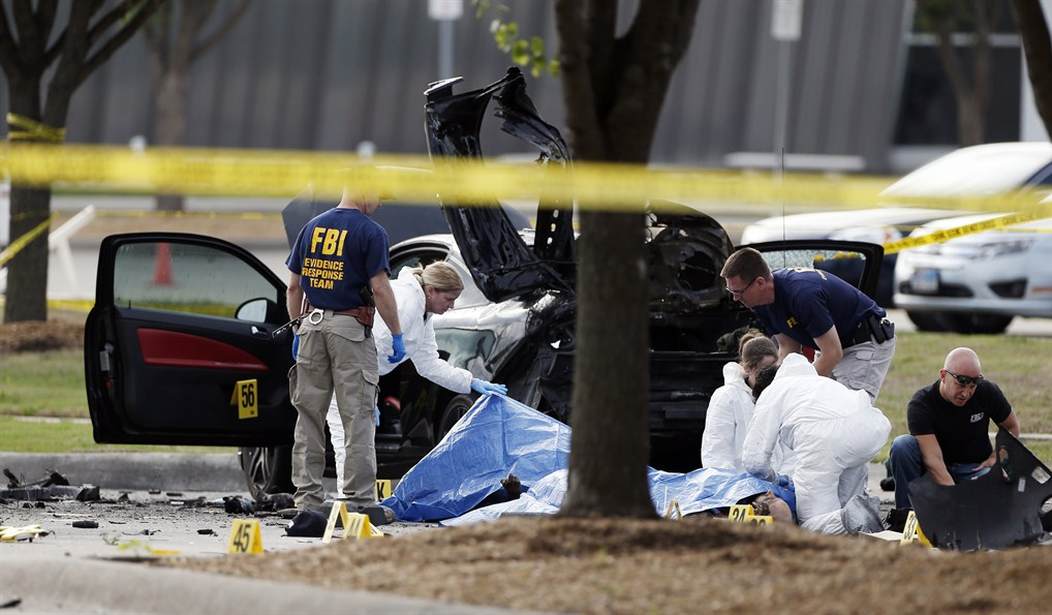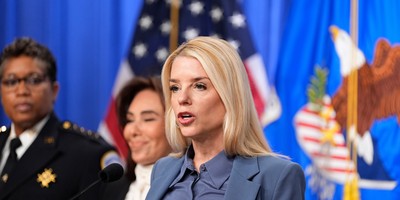With Muhammad cartoons back in the forefront, it’s resurrected a debate within the media about free speech. So, what are the numbers? In the aftermath of the horrific Charlie Hebdo shootings in Paris last winter, 60 percent of Americans said it was “okay” to publish cartoons of Muhammad. Moreover, an overwhelming majority said that people should have “the right to say what they believe even if they take positions that seem deeply offensive to most people.” Yet, there is a caveat (via WaPo):

However, American support for pushing First Amendment boundaries is not absolute. Last year the First Amendment Center found that nearly 40 percent of Americans say the First Amendment "goes too far" in the rights it guarantees, a near-record high. And in 2010 the survey found that while a majority of Americans -- 53 percent -- said people should be allowed to say things in public that are offensive to religious groups, fewer (44 percent) said the same about speech that is offensive to racial groups.
Some in the media seem to be channeling the sentiment of the former in the First Amendment Center Survey. In the aftermath of the Garland shooting, Rukmini Callimachi, New York Times’ Foreign Correspondent, tweeted “free speech aside, why would anyone do something as provocative as hosting a ‘Muhammad drawing contest’?” Keep in mind that Callimachi tweeted about the “touching” ABC News story on one of the Hebdo victims in March.
It's a bit worrisome that some members of the media are more concerned about provocation than the insane reaction from a member of the Islamic community who sees a cartoon, gets angry, and then grabs an assault rifle to engage in the slaughter of innocents. The exercise of free speech is more disconcerting than the reaction to a cartoon; that’s ridiculous. Who knew that cartoons were the mother of all microaggressions?
Recommended
There are some who feel that there are limits to free speech–and they use the “shouting fire in a crowded theater” argument to demonstrate that point. Yet, the case law behind this statement has horrific origins, and would probably make anyone think twice before using it in a future debate on the subject. Sen. Chuck Schumer (D-NY) used this as an example in an op-ed to push for gun control in 2013 since–in his mind–“the First Amendment is not absolute. No Amendment is absolute.” Thus, the same standard is applied to the Second Amendment. National Review’s Charles Cooke broke down why we should stop using the “fire” argument since it’s pretty much proto-fascist:
This fire-in-a-theater jazz is a favorite of the less historically literate among America’s false-compromisers, most of whom know neither that the phrase was a (defective) analogy and not a legal doctrine, nor that the case from which it comes was subsequently overturned with some prejudice. Also generally unknown, but crucial, is what Oliver Wendell Holmes and his colleagues were (unanimously) doing in that case. Nine to nothing, they were upholding the Espionage Act of 1917, that baleful resurrection of the Alien and Sedition Acts that so stained the liberty of the republic during its brief flirtation with fascism. In doing so, Holmes and Co. were endorsing the half-year prison sentence that had been inflicted upon the plaintiff, Russian exile and secretary of the Socialist party Charles Schenck, for having the temerity to oppose in public his new country’s involvement in World War I.It is a detestable irony that in exchange for handing out anti-draft leaflets reading, “Do not submit to intimidation” and “If you do not assert and support your rights, you are helping to deny or disparage rights which it is the solemn duty of all citizens and residents of the United States to retain,” Schenck was not only put in prison but used as a symbol to signal the court’s pusillanimity in the face of the Wilson presidency: a majority upholding a majority against the little guy. And on what grounds? Because the United States, whose nearest border lay more than 3,000 miles away from the horrors of the Western Front, was ostensibly in “clear and present danger,” and Schenck’s leaflets — not even written in English — were such a mortal menace to the war effort that they had to be repressed. “Because the most stringent protection of free speech would not protect a man in falsely shouting fire in a theater and causing a panic,” the Court reasoned, the Wilson administration could imprison anti-war types whose words damaged recruiting, or even just “morale.”
Again, I certainly do not agree with Schenck’s politics, but he had every right to oppose our entry into World War I.
Recently, CNN’s Chris Cuomo put his constitutional acumen to the test where he tweeted that hate speech wasn’t protected. Oh, and that we should read the Constitution, or something. Of course, he found himself besieged for this rather idiotic interpretation of the First Amendment. Even Glenn Greenwald, who is not a conservative in the slightest, commented that Cuomo’s tweet was “painfully dumb.” Not backing down, Cuomo said we should all Google “Chaplinsky,” a reference to Chaplinsky V. New Hampshire.
In this case, Walter Chaplinsky, a member of Jehovah’s Witness, was distributing literature on a public sidewalk; the crowd were upset that he was describing all other organized religions as a “racket;” he was thrown in jail, but not after he called the town marshal a “damned fascist;” the Supreme Court upheld that New Hampshire’s law barring "any offensive, derisive or annoying word to any other person who is lawfully in any street or other public place” or "call him by any offensive or derisive name" did not violate free speech. Yet, it has no relevance with Charlie Hebdo, the Garland shooting, or Cuomo’s supposed, “look, I was right” moment.
it doesn't. hate speech is excluded from protection. dont just say you love the constitution...read it https://t.co/znZJ8cPvpX
— Chris Cuomo (@ChrisCuomo) May 6, 2015Such a painfully dumb tweet! @ChrisCuomo: can you point to where this free speech "exception" is in US Constitution? https://t.co/Z4yCw7IrsQ
— Glenn Greenwald (@ggreenwald) May 6, 2015“@FilmLadd: Apparently @ChrisCuomo missed the "dumbass speech prohibition" in the Constitution, too.” Chaplinsky. Now shut up
— Chris Cuomo (@ChrisCuomo) May 6, 2015In fact, a better case to demonstrate free speech within the context of hate speech is the 1969 Brandenburg v. Ohio case:
Appellant, a Ku Klux Klan leader, was convicted under the Ohio Criminal Syndicalism statute for "advocat[ing] . . . the duty, necessity, or propriety of crime, sabotage, violence, or unlawful methods of terrorism as a means of accomplishing industrial or political reform" and for "voluntarily assembl[ing] with any society, group or assemblage of persons formed to teach or advocate the doctrines of criminal syndicalism." Neither the indictment nor the trial judge's instructions refined the statute's definition of the crime in terms of mere advocacy not distinguished from incitement to imminent lawless action. Held: Since the statute, by its words and as applied, purports to punish mere advocacy and to forbid, on pain of criminal punishment, assembly with others merely to advocate the described type of action, it falls within the condemnation of the First and Fourteenth Amendments. Freedoms of speech and press do not permit a State to forbid advocacy of the use of force or of law violation except where such advocacy is directed to inciting or producing imminent lawless action and is likely to incite or produce such action.
So, yes, all forms of speech–even those fraught with hate–have some form of protection.
Drawing cartoons of Muhammad in the United States have yet to incite rioting or lawless behavior. Even at events that are openly racist, such mayhem doesn’t ensue since the vast majority of Americans do not agree with the views of Nazis or white nationalists. In fact, at times, such events organized by racists are cancelled since the counter protests are so much greater, police cannot guarantee security.
Heck, even the White House is with us on this one. I mean, I would hope everyone would be since Garland was an ISIS-linked terror attack.
Free speech is free speech. I may not like people burning the American flag, advocating far-left views, or calling members of my race a “chink, gook, or slope,” but they have every right to make such remarks–and I have every right to stand right there next to them and say they’re wrong.
Last Note: Congratulations to Bosch Fawstin, winner of the Garland Muhammad cartoon drawing contest, on his $10,000 prize.
AllahPundit has more over at Hot Air on this matter. Oh, and the "fighting words" standard Cuomo references when citing Chaplinksy with regard to hate speech was more or less settled in 1992 with R.A.V v. St. Paul. Spoiler alert: Minnesota's fighting words ordinance was ruled unconstitutional.
Oh, and again ... No.
For last time (today), I didn't mean the language of 1A, I meant the case law. And hate speech has been protected except for fighting words.
— Chris Cuomo (@ChrisCuomo) May 6, 2015UPDATE: Ed Morrissey noted the SCOTUS upheld speech from Westboro Baptist Church.
@BenHowe @ChrisCuomo Just to give Chris a hint, SCOTUS upheld #1A protection for Westboro protests ("hate speech") 8-1 in Snyder v Phelps.
— Ed Morrissey (@EdMorrissey) May 6, 2015
























Join the conversation as a VIP Member